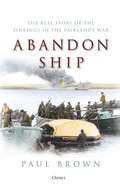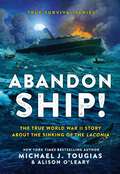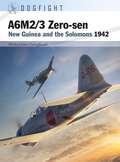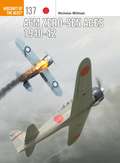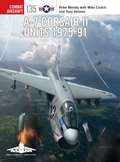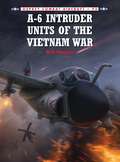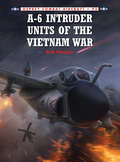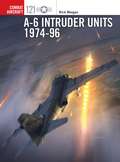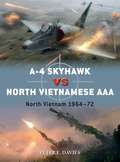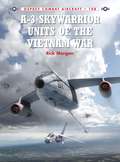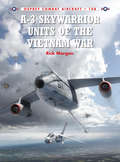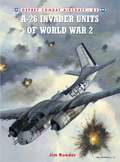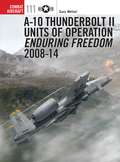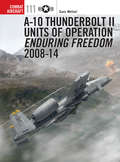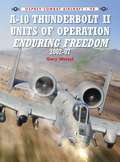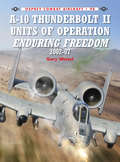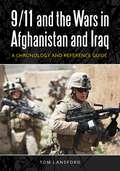- Table View
- List View
Abandon Ship: The Real Story of the Sinkings in the Falklands War
by Paul BrownWhen Argentinian forces invaded the Falklands in April 1982, the British government responded by despatching a task force to the Atlantic to wrest back control of the islands. The resulting war saw modern weapon systems tested in combat for the first time, to tragic effect. In the aftermath, official documents were released, but many were heavily censored, and others withheld altogether, so that a full understanding of those events could not be gained. Drawing from recently declassified and previously unpublished reports from the official inquiry, Dr Paul Brown details the true story behind the dramatic events that led to the loss of six British ships – HMS Antelope, Ardent, Coventry and Sheffield, RFA Sir Galahad and SS Atlantic Conveyor – as well as the controversial sinking of the Argentinian cruiser ARA General Belgrano by HMS Conqueror.
Abandon Ship!: The True World War II Story About the Sinking of the Laconia (True Survival Series #1)
by Michael J. Tougias Alison O'LearyA remarkable World War II account of a maritime attack off the West African coast, for fans of Steven Sheinkin and Deborah Heiligman. At the height of World War II, the RMS Laconia was torpedoed by a German submarine five hundred miles off the coast of western Africa. The attack triggered a series of unprecedented events involving allies and enemies from both sides, and left survivors adrift at sea in shark infested oceans, fighting to stay alive with little food or water. Suspenseful and informative, and featuring historic photographs, this incredible true account is a testament to the idea that compassion can rule over conflict—even during the cruelties of war. A Junior Library Guild Gold Standard Selection "This epic story races along, unspooling like a movie before our eyes—artfully, dramatically, revealing a little known part of WWII history. An intriguing book."―Doug Stanton, #1 New York Times bestselling author of In Harm&’s Way "The authors do an excellent job of conveying the chaos and loss of this grisly historical incident without pushing young readers too deeply into the horror. Many of those who lived through the Laconia catastrophe endured weeks at sea, parched and sunburned and starving in conditions that literally drove men mad. Archival photos add immediacy to this sensational true-life story." ―Wall Street Journal "An amazing account of a World War II event that is almost entirely unknown…. This story chronicles the courage, compassion, and perseverance of the few survivors of the incident, showcasing war at its worst and humanity at its best…. School librarians will want to add this to their collection." ―Booklist
A6M2/3 Zero-sen: New Guinea and the Solomons 1942 (Dogfight #10)
by Mr Michael John ClaringbouldThis book details the exploits of the highly skilled Naval Aviators charged with achieving air supremacy over New Guinea in their A6M2/3 Zero-sens. The combat record of the Zero-sen in New Guinea has mostly been overstated, with little due being given to the constraining conditions under which the fighter operated. The air combats fought over New Guinea in 1942 between Imperial Japanese Naval Air Force (IJNAF) pilots and their Allied counterparts in P-39 Airacobras and P-40 Warhawks were often 'trial and error' affairs, with both belligerents being caught out by weather. This study covers the key role played by governing factors including geography and climatic conditions, and examines the modified tactics employed by IJNAF Zero-sen pilots to help them cope in-theatre through the comprehensive analysis of RAAF, USAAF and Japanese operational after action reports. Using first-hand accounts from both famous aviators and previously unknown RAAF and Japanese pilots, and specially commissioned artwork, leading South Pacific historian and author Michael John Claringbould sheds new light on the air war fought over the wilds of New Guinea during the course of 1942.
A6M2/3 Zero-sen: New Guinea and the Solomons 1942 (Dogfight #10)
by Mr Michael John ClaringbouldThis book details the exploits of the highly skilled Naval Aviators charged with achieving air supremacy over New Guinea in their A6M2/3 Zero-sens. The combat record of the Zero-sen in New Guinea has mostly been overstated, with little due being given to the constraining conditions under which the fighter operated. The air combats fought over New Guinea in 1942 between Imperial Japanese Naval Air Force (IJNAF) pilots and their Allied counterparts in P-39 Airacobras and P-40 Warhawks were often 'trial and error' affairs, with both belligerents being caught out by weather. This study covers the key role played by governing factors including geography and climatic conditions, and examines the modified tactics employed by IJNAF Zero-sen pilots to help them cope in-theatre through the comprehensive analysis of RAAF, USAAF and Japanese operational after action reports. Using first-hand accounts from both famous aviators and previously unknown RAAF and Japanese pilots, and specially commissioned artwork, leading South Pacific historian and author Michael John Claringbould sheds new light on the air war fought over the wilds of New Guinea during the course of 1942.
A6M Zero-sen Aces 1940-42 (Aircraft of the Aces)
by Nicholas MillmanThe Mitsubishi A6M Zero-sen was Japan's Spitfire. In continuous development and operational service from the time of the Sino-Japanese war in 1940 to the end of the Pacific War in 1945, it is held in almost mythical awe, similar to Britain's legendary fighter aircraft. At the time of its operational debut the fighter's design features offered the revolutionary combination of an all-round vision canopy, cannon armament and a jettisonable drop tank giving it phenomenal range. Together with the flying and tactical proficiency of superbly trained pilots, this made the Zero-sen a true strategic fighter, spearheading Japan's offensive in the Pacific. It was also the mount of a plethora of successful and flamboyant naval aces engaged in both sea and land campaigns. This volume, the first of two on the A6M Zero-sen, covers the use of the A6M2 variant from its debut in China to the Solomons Campaign, and also tells the story of the A6M2-N "Rufe" floatplane fighter aces.
A6M Zero-sen Aces 1940-42 (Aircraft of the Aces #137)
by Nicholas MillmanThe Mitsubishi A6M Zero-sen was Japan's Spitfire. In continuous development and operational service from the time of the Sino-Japanese war in 1940 to the end of the Pacific War in 1945, it is held in almost mythical awe, similar to Britain's legendary fighter aircraft. At the time of its operational debut the fighter's design features offered the revolutionary combination of an all-round vision canopy, cannon armament and a jettisonable drop tank giving it phenomenal range. Together with the flying and tactical proficiency of superbly trained pilots, this made the Zero-sen a true strategic fighter, spearheading Japan's offensive in the Pacific. It was also the mount of a plethora of successful and flamboyant naval aces engaged in both sea and land campaigns. This volume, the first of two on the A6M Zero-sen, covers the use of the A6M2 variant from its debut in China to the Solomons Campaign, and also tells the story of the A6M2-N "Rufe" floatplane fighter aces.
A-7 Corsair II Units 1975-91 (Combat Aircraft)
by Peter MerskyAt the A-7 Corsair II's peak in the mid-1980s, some 30 US Navy squadrons flew various versions of the aircraft, including six Naval Air Reserve units, and these many of these units saw action across the Middle East. By the time the jet saw combat in Operation Desert Storm (1991), there remained only two fleet squadrons – many fleet squadrons having either disestablished or transitioned to the F/A18 Hornet – but both of these units (VA-46 and VA-72) played a major role in the campaign to free Kuwait. The book details the technological development and improvements that were introduced to the airframe post-Vietnam (the FLIR targeting pod from 1979 and AGM-88 HARM missile from 1983 being the most important), and how they shaped operational employment of the aircraft. The jet's combat experiences in conflicts during the 1970s (Cambodia), 1980s (Lebanon, Grenada, Libya and Iran), and 1990s (Iraq) are explained in detail, and Peter Mersky's expert analysis is supported by numerous first-hand accounts from naval aviators that saw action with the A-7 during these campaigns.
A-7 Corsair II Units 1975-91 (Combat Aircraft)
by Peter MerskyAt the A-7 Corsair II's peak in the mid-1980s, some 30 US Navy squadrons flew various versions of the aircraft, including six Naval Air Reserve units, and these many of these units saw action across the Middle East. By the time the jet saw combat in Operation Desert Storm (1991), there remained only two fleet squadrons – many fleet squadrons having either disestablished or transitioned to the F/A18 Hornet – but both of these units (VA-46 and VA-72) played a major role in the campaign to free Kuwait. The book details the technological development and improvements that were introduced to the airframe post-Vietnam (the FLIR targeting pod from 1979 and AGM-88 HARM missile from 1983 being the most important), and how they shaped operational employment of the aircraft. The jet's combat experiences in conflicts during the 1970s (Cambodia), 1980s (Lebanon, Grenada, Libya and Iran), and 1990s (Iraq) are explained in detail, and Peter Mersky's expert analysis is supported by numerous first-hand accounts from naval aviators that saw action with the A-7 during these campaigns.
A-6 Intruder Units of the Vietnam War (Combat Aircraft)
by Jim Laurier Rick MorganDesigned in the years following the Korean War and then manufactured for over 30 years starting in 1960, the A-6 quickly became the most capable attack aircraft in the US Navy's stable. The first squadron, VA-75, made its initial deployment directly into combat in south-east Asia in 1965, and, over the next eight years, ten US Navy and four Marine Intruder squadrons would conduct combat operations throughout Vietnam, Laos and Cambodia. After initial problems and a high loss rate, the type proved itself beyond all doubt as the Naval services' best night and foul-weather platform, particularly during the region's notorious monsoon season. The A-6 Intruder became a true classic of naval aviation over the skies of North Vietnam but the cost was high as 69 Intruders were lost in combat to all causes during the war. This work tells the complete story of these aircraft in combat during the Vietnam War.
A-6 Intruder Units of the Vietnam War (Combat Aircraft)
by Jim Laurier Rick MorganDesigned in the years following the Korean War and then manufactured for over 30 years starting in 1960, the A-6 quickly became the most capable attack aircraft in the US Navy's stable. The first squadron, VA-75, made its initial deployment directly into combat in south-east Asia in 1965, and, over the next eight years, ten US Navy and four Marine Intruder squadrons would conduct combat operations throughout Vietnam, Laos and Cambodia. After initial problems and a high loss rate, the type proved itself beyond all doubt as the Naval services' best night and foul-weather platform, particularly during the region's notorious monsoon season. The A-6 Intruder became a true classic of naval aviation over the skies of North Vietnam but the cost was high as 69 Intruders were lost in combat to all causes during the war. This work tells the complete story of these aircraft in combat during the Vietnam War.
A-6 Intruder Units 1974-96 (Combat Aircraft)
by Jim Laurier Rick Morgan Gareth HectorIn the three decades following Vietnam, the veteran A-6 Intruder remained the most powerful strike aircraft available to the US Navy and Marine Corps. Engaged in operations over Cambodia, Lebanon and Libya during the 1970s and 80s, the A-6 maintained its reputation as the 'Main Battery' of carrier aviation, remaining in service through the First Gulf War up until 1996 when its duties were taken over by the F-14 Tomcat. Following on from his study of the A-6 Intruder's exploits during the Vietnam War, Rick Morgan details the technological developments that were introduced to the airframe after that conflict and how it shaped the operational employment of the aircraft. Filled with first-hand accounts from pilots and navigators, as well as profile artwork and photographs, this is the complete story of the US Navy's main medium attack aircraft in the latter part of the Cold War.
A-6 Intruder Units 1974-96 (Combat Aircraft #121)
by Jim Laurier Rick Morgan Gareth HectorIn the three decades following Vietnam, the veteran A-6 Intruder remained the most powerful strike aircraft available to the US Navy and Marine Corps. Engaged in operations over Cambodia, Lebanon and Libya during the 1970s and 80s, the A-6 maintained its reputation as the 'Main Battery' of carrier aviation, remaining in service through the First Gulf War up until 1996 when its duties were taken over by the F-14 Tomcat. Following on from his study of the A-6 Intruder's exploits during the Vietnam War, Rick Morgan details the technological developments that were introduced to the airframe after that conflict and how it shaped the operational employment of the aircraft. Filled with first-hand accounts from pilots and navigators, as well as profile artwork and photographs, this is the complete story of the US Navy's main medium attack aircraft in the latter part of the Cold War.
A-4 Skyhawk vs North Vietnamese AAA: North Vietnam 1964–72 (Duel)
by Peter E. DaviesWhile the F105 Thunderchief was the USAF's principal strike weapon during the Rolling Thunder campaign, the US Navy relied on the Douglas A-4 Skyhawk for the majority of its strikes on North Vietnam. The Skyhawk entered service in 1956 and remained in continuous production for 26 years. Throughout Operation Rolling Thunder it was the US Navy's principal daytime light strike bomber, remaining in use after its replacement, the more sophisticated A-7 Corsair II, began to appear in December 1967. During the 1965–68 Rolling Thunder period, up to five attack carriers regularly launched A-4 strike formations against North Vietnam. These formations faced an ever-expanding and increasingly coordinated Soviet-style network of anti-aircraft artillery missiles and fighters. Skyhawk pilots were often given the hazardous task of attacking anti-aircraft defences and to improve accuracy, they initially dropped ordnance below 3000 ft in a 30-degree dive in order to bomb visually below the persistent low cloud over North Vietnam, putting the aircraft within range of small-arms fire. The defenders had the advantage of covering a relatively small target area, and the sheer weight of light, medium and heavy gunfire directed at an attacking force brought inevitable casualties, and a single rifle bullet could have the same effect as a larger shell. This illustrated title examines both the A-4 Skyhawk and the Vietnamese AAA defences in context, exploring their history and analysing their tactics and effectiveness during the conflict.
A-4 Skyhawk vs North Vietnamese AAA: North Vietnam 1964–72 (Duel #104)
by Peter E. DaviesWhile the F105 Thunderchief was the USAF's principal strike weapon during the Rolling Thunder campaign, the US Navy relied on the Douglas A-4 Skyhawk for the majority of its strikes on North Vietnam. The Skyhawk entered service in 1956 and remained in continuous production for 26 years. Throughout Operation Rolling Thunder it was the US Navy's principal daytime light strike bomber, remaining in use after its replacement, the more sophisticated A-7 Corsair II, began to appear in December 1967. During the 1965–68 Rolling Thunder period, up to five attack carriers regularly launched A-4 strike formations against North Vietnam. These formations faced an ever-expanding and increasingly coordinated Soviet-style network of anti-aircraft artillery missiles and fighters. Skyhawk pilots were often given the hazardous task of attacking anti-aircraft defences and to improve accuracy, they initially dropped ordnance below 3000 ft in a 30-degree dive in order to bomb visually below the persistent low cloud over North Vietnam, putting the aircraft within range of small-arms fire. The defenders had the advantage of covering a relatively small target area, and the sheer weight of light, medium and heavy gunfire directed at an attacking force brought inevitable casualties, and a single rifle bullet could have the same effect as a larger shell. This illustrated title examines both the A-4 Skyhawk and the Vietnamese AAA defences in context, exploring their history and analysing their tactics and effectiveness during the conflict.
A-3 Skywarrior Units of the Vietnam War (Combat Aircraft #108)
by Jim Laurier Rick Morgan Gareth HectorThe Douglas A-3 Skywarrior, though something of a cult favourite, remains a largely unremarked classic of Naval Aviation. Built for nuclear weapon delivery, the A-3 made its name in Vietnam as a conventional bomber, tanker and Electronic Warfare platform. It was the largest aircraft ever regularly operated from the decks of aircraft carriers, earning it the fleet-wide nickname 'Whale'. It excelled in every mission area assigned to it and operated in the US Navy for more than four decades, from 1956 through to 1991. Fully illustrated to depict the incredible array of paint schemes and its awesome size, this volume focuses on the type's Vietnam service, which saw the aircraft briefly used as a bomber over both North and South Vietnam from March 1965, before the Skywarrior proved far more valuable as a multi-role tanker (KA-3B) and tanker/tactical jammer (EKA-3B). The title includes details on all of these operations as well as more clandestine reconnaissance missions, and provides information about the men that flew them.
A-3 Skywarrior Units of the Vietnam War (Combat Aircraft #108)
by Jim Laurier Rick Morgan Gareth HectorThe Douglas A-3 Skywarrior, though something of a cult favourite, remains a largely unremarked classic of Naval Aviation. Built for nuclear weapon delivery, the A-3 made its name in Vietnam as a conventional bomber, tanker and Electronic Warfare platform. It was the largest aircraft ever regularly operated from the decks of aircraft carriers, earning it the fleet-wide nickname 'Whale'. It excelled in every mission area assigned to it and operated in the US Navy for more than four decades, from 1956 through to 1991. Fully illustrated to depict the incredible array of paint schemes and its awesome size, this volume focuses on the type's Vietnam service, which saw the aircraft briefly used as a bomber over both North and South Vietnam from March 1965, before the Skywarrior proved far more valuable as a multi-role tanker (KA-3B) and tanker/tactical jammer (EKA-3B). The title includes details on all of these operations as well as more clandestine reconnaissance missions, and provides information about the men that flew them.
A-26 Invader Units of World War 2 (Combat Aircraft)
by Janusz Swiatlon Jim RoederDesigned to combine the bombing capability of the B-26 Marauder with the versatility of the ground-attack A-20 Havoc, the A-26 Invader would become the USAAF's attack bomber par excellence. Capable of flying low-level strafing or conventional bombing missions by simply changing the nose configuration of the aircraft, the Invader first saw action in 1943 in the Pacific Theatre attacking Japanese-held islands. Arriving in Europe several months later, the A-26 served with distinction for the remainder of World War 2. In fact, the design proved so successful that it would go on to fly combat missions for a further two decades. Written by military aviation expert, Jerry Scutts, and illustrated with brand-new colour profiles and rare photography, this is the first book to focus exclusively on the A-26's missions in World War 2.
A-26 Invader Units of World War 2 (Combat Aircraft #82)
by Janusz Swiatlon Jim RoederDesigned to combine the bombing capability of the B-26 Marauder with the versatility of the ground-attack A-20 Havoc, the A-26 Invader would become the USAAF's attack bomber par excellence. Capable of flying low-level strafing or conventional bombing missions by simply changing the nose configuration of the aircraft, the Invader first saw action in 1943 in the Pacific Theatre attacking Japanese-held islands. Arriving in Europe several months later, the A-26 served with distinction for the remainder of World War 2. In fact, the design proved so successful that it would go on to fly combat missions for a further two decades. Written by military aviation expert, Jerry Scutts, and illustrated with brand-new colour profiles and rare photography, this is the first book to focus exclusively on the A-26's missions in World War 2.
A-10 Thunderbolt II Units of Operation Enduring Freedom 2008-14 (Combat Aircraft)
by Jim Laurier Gary WetzelThe untold story of A-10 units in Operation Enduring Freedom reaches its conclusion with this second of two volumes focusing on the type's combat missions in Afghanistan. Featuring numerous first-hand accounts and photography from those who experienced the conflict, along with imagery from official military archives, this book offers a unique and detailed insight into the record of the A-10 in one of the 21st Century's most significant conflicts. Initially, the A-10 Thunderbolt was not a favourite of the USAF, which, prior to the Iraqi invasion of Kuwait in 1990, was hoping to shunt this Cold War relic onto the US Army and Marine Corps. But since then the 'Warthog', with its formidable armament, ruggedness and flexibility, has continually proven itself in combat and evolved into the world's premiere close support aircraft. In 2002 the Thunderbolt was at the forefront of Operation Enduring Freedom, the US occupation of Afghanistan.
A-10 Thunderbolt II Units of Operation Enduring Freedom 2008-14 (Combat Aircraft #111)
by Jim Laurier Gary WetzelThe untold story of A-10 units in Operation Enduring Freedom reaches its conclusion with this second of two volumes focusing on the type's combat missions in Afghanistan. Featuring numerous first-hand accounts and photography from those who experienced the conflict, along with imagery from official military archives, this book offers a unique and detailed insight into the record of the A-10 in one of the 21st Century's most significant conflicts. Initially, the A-10 Thunderbolt was not a favourite of the USAF, which, prior to the Iraqi invasion of Kuwait in 1990, was hoping to shunt this Cold War relic onto the US Army and Marine Corps. But since then the 'Warthog', with its formidable armament, ruggedness and flexibility, has continually proven itself in combat and evolved into the world's premiere close support aircraft. In 2002 the Thunderbolt was at the forefront of Operation Enduring Freedom, the US occupation of Afghanistan.
A-10 Thunderbolt II Units of Operation Enduring Freedom 2002-07 (Combat Aircraft #98)
by Jim Laurier Gary WetzelThe A-10 was never a favourite amongst the USAF's senior staff, and prior to Iraq's invasion of Kuwait in 1990 they had attempted to transfer the aircraft to the US Army and Marine Corps. Reprieved from premature retirement, the A-10 would see combat in the Balkans during the mid-1990s and over Iraq in Operations Northern Watch and Southern Watch until Operation Iraqi Freedom began in 2003. Following the 11 September 2001 attacks in the United States, the Bush administration responded with the instigation of Operation Enduring Freedom. A-10 aircraft first entered the fray during Operation Anaconda in March 2002. During Anaconda four A-10s flying from Pakistan provided 21 straight hours of FAC (A)/CAS coverage. The untold story of the A-10 in Enduring Freedom will be explored and presented as never before through first hand interviews and photography from those involved, along with official military achieves. This title is the first of three planned covering the combat experience of the USAF's A-10 Thunderbolt II units. Follow-on volumes will examine the role of the Warthog during Operation Desert Storm and Operation Iraqi Freedom.
A-10 Thunderbolt II Units of Operation Enduring Freedom 2002-07 (Combat Aircraft #98)
by Jim Laurier Gary WetzelThe A-10 was never a favourite amongst the USAF's senior staff, and prior to Iraq's invasion of Kuwait in 1990 they had attempted to transfer the aircraft to the US Army and Marine Corps. Reprieved from premature retirement, the A-10 would see combat in the Balkans during the mid-1990s and over Iraq in Operations Northern Watch and Southern Watch until Operation Iraqi Freedom began in 2003. Following the 11 September 2001 attacks in the United States, the Bush administration responded with the instigation of Operation Enduring Freedom. A-10 aircraft first entered the fray during Operation Anaconda in March 2002. During Anaconda four A-10s flying from Pakistan provided 21 straight hours of FAC (A)/CAS coverage. The untold story of the A-10 in Enduring Freedom will be explored and presented as never before through first hand interviews and photography from those involved, along with official military achieves. This title is the first of three planned covering the combat experience of the USAF's A-10 Thunderbolt II units. Follow-on volumes will examine the role of the Warthog during Operation Desert Storm and Operation Iraqi Freedom.
The 9/11 Wars
by Jason BurkeDAILY TELEGRAPH, ECONOMIST AND INDEPENDENT BOOKS OF THE YEARThroughout the 1990s a vast conflict was brewing. The storm broke on September 11th 2001. Since then much of the world has seen invasions, bombings, battles and riots. Hundreds of thousands of people have died. Jason Burke, a first-hand witness of many of the conflict's key moments, has written the definitive account of its course in his acclaimed book The 9/11 Wars.At once investigation, reportage and contemporary history, The 9/11 Wars is an essential book for understanding the dangerous and unstable twenty-first century. Whether reporting on the riots in France or the attack on Mumbai, suicide bombers in Iraq or British troops fighting in Helmand, Jason Burke tells the story of a world that changed forever when the hijacked planes flew out of the brilliant blue sky above Manhattan on September 11th.Reviews:'The best overview of the 9/11 decade so far in print' Economist'A magisterial history of the last decade ... The long patient sentences of The 9/11 Wars are suffused with the melancholy of a man who has learned a great deal from long exposure to atrocity and folly' Pankaj Mishra, Guardian'The 9/11 Wars warrants great respect' Metro'Pacy, well-researched, and packed with telling anecdotes, this book's strength is in its detailed, balanced overview ... At a time when there are more books out on terrorism than ever before ... this is likely to be among the best' Sunday Telegraph'[Burke] is one of the most respected and experienced foreign correspondents in the business ... A major authority on the politics and organisation of Islamic extremism and ... a talented writer with the rare gift of joining effortless prose to challenging scholarship ... [The 9/11 Wars] is a magnificent achievement' Irish Times'A reader wanting a more dispassionate survey of how 9/11, and the response to it, may have shaped parts of the world will do no better than invest in [this] brilliant book' David Aaronovitch, The Times'This remarkably balanced, well-sourced and very well-written book ... will be turned to in the future ... [Burke] has demonstrated impressive expertise as a historian who has had the advantage of having been present on many of the battlefields he describes' Andrew Roberts, Evening Standard'[A] lucid, sane account ... taut, careful reporting ... Remarkable' Scotsman'Potent ... journalism of a high order. Like all good reporters, Burke is something of a scholar, drawing meticulously on interview notes years old, and on extensive background reading. He excels, too, in describing the experiences of ordinary Muslims; such insights make this book essential for understanding the past decade' Sunday TimesAbout the author:Jason Burke is the South Asia correspondent for the Guardian. He has reported around the world for both the Guardian and the Observer. He is the author of two other widely praised books, both published by Penguin: Al-Qaeda and On the Road to Kandahar. He lives in New Delhi.
The 9/11 Dogs: The Heroes Who Searched For Survivors At The Twin Towers (HarperTrue Friend – A Short Read)
by Isabel GeorgeMeet the dogs who searched for life amongst the ruins of the Twin Towers.
9/11 and the Wars in Afghanistan and Iraq: A Chronology and Reference Guide
by Tom LansfordThis book analyzes the complex causes and effects of the September 11, 2001, terrorist attacks both domestically and internationally, and examines the subsequent wars in Afghanistan and Iraq.The first decade of the 21st century witnessed a watershed of political, economic, diplomatic, and military change as a direct result of the events of September 11, 2001. Through narrative chapters, a chronology of events, biographical sketches of principal players, and annotated primary documents, author Tom Lansford documents the domestic impact of the terrorist attacks that stunned the world as well as the subsequent "war on terror" and the invasions and occupations of Afghanistan and Iraq.9/11 and the Wars in Afghanistan and Iraq: A Chronology and Reference Guide explores the origins and aftermath of the September 11, 2001, terrorist attacks in both the domestic and international contexts. It addresses the rise of global terrorism and the concurrent histories of Afghanistan, Iraq, and the broader Middle East, as well as the interaction of the United States with the region. Events, trends, groups, and individual players are examined as part of the broader historical context, allowing readers to see the connections between these various elements.
